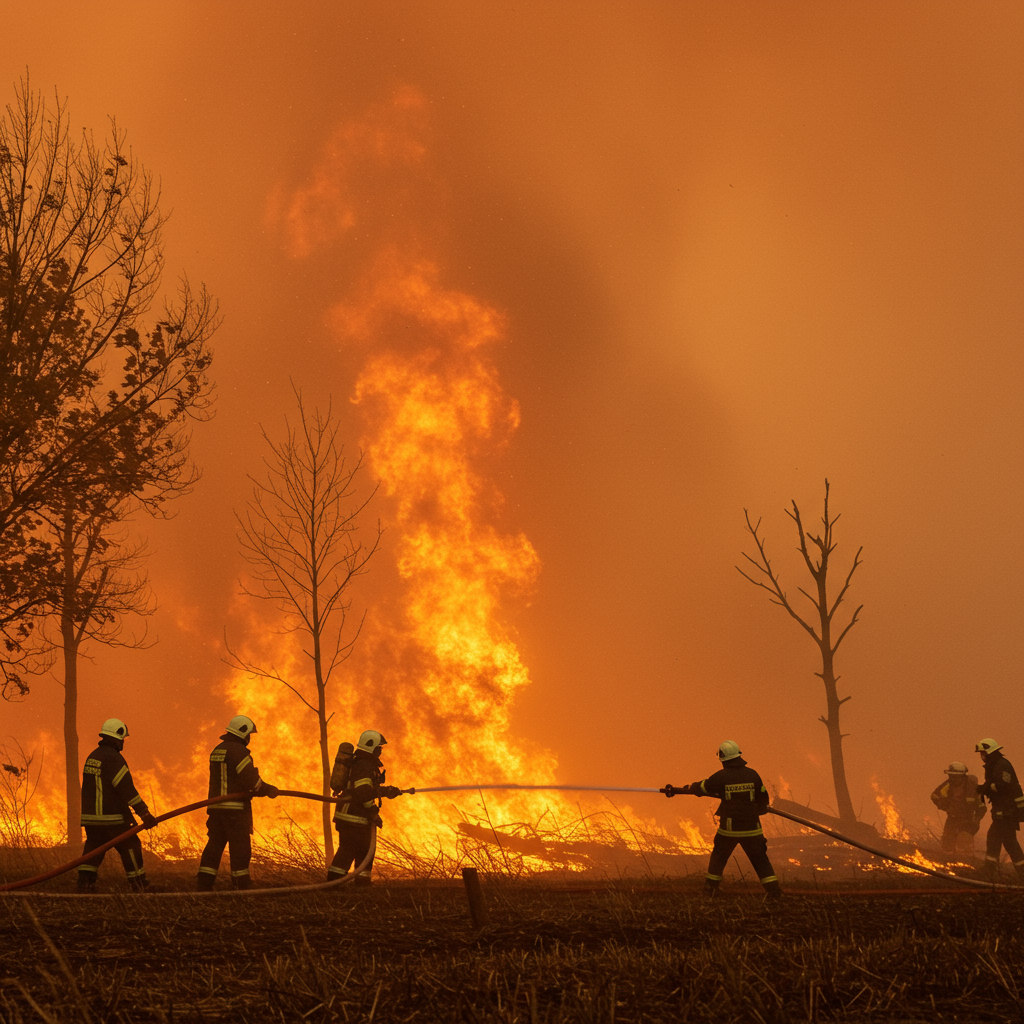europe is currently grappling with an unprecedented early summer heatwave, triggering devastating wildfires across multiple countries and forcing thousands of people to flee their homes. As sweltering conditions bake the continent, firefighters are battling intense blazes from Turkey to France, with many regions experiencing temperatures far exceeding seasonal norms. Health alerts have been issued in several nations, and the combination of extreme heat and rampant fires is posing significant risks to communities, infrastructure, and the environment. This escalating crisis underscores the growing impact of a changing climate on weather patterns and disaster frequency across Europe.
Early Summer Heatwave Grips Europe
An unusual and intense heatwave has settled over large parts of Western and Southern Europe, arriving weeks earlier than typically expected. Experts note that temperatures in some locations are soaring 5-10 degrees Celsius above average for late June. Samantha Burgess, Strategic Lead for Climate at the EU’s Copernicus Climate Change Service, confirmed that “Large parts of Western Europe are experiencing extreme heat and heatwave conditions that are normally observed in July or August, rather than June.”
This scorching heat is impacting a wide swathe of the continent. Health alerts have been activated in countries like France, Spain, Italy, Portugal, and Germany. Even the Netherlands, known for its more temperate climate, has issued warnings as high temperatures combine with humidity. Spain is on track to record its hottest June ever, with temperatures reaching 42°C in Seville and a peak of 43.7°C registered in El Granado. In Italy, the health ministry placed 16 cities under “red alert” for heatwave risk, including major centers like Rome and Milan. Germany also saw temperatures climb up to 34°C in western and southwestern regions, leading authorities to urge consumers to conserve water. This widespread and intense early heat is setting dangerous conditions across the continent.
Wildfires Rage Across Multiple Fronts
Fueled by the extreme heat and often fanned by strong winds, wildfires are erupting and spreading rapidly across several European nations. In Turkey, blazes have forced more than 50,000 people to evacuate from five regions, with over 42,000 displaced in the western province of Izmir alone. Forestry Minister Ibrahim Yumakli reported these fires were fanned by strong winds, raging for a second day in Izmir. Turkey’s coastal regions have faced increasing wildfire threats in recent years, as summers become hotter and drier, a pattern scientists link to human-induced climate change. Past fire seasons, like the devastating blazes in August 2021 that claimed eight lives and forced over 36,000 evacuations in Mugla province, including near a power plant, highlight the recurring vulnerability of these areas.
France is also battling significant fires. In the southwestern Aude department, where temperatures topped 40°C, fires broke out, burning 400 hectares and necessitating the evacuation of a campsite and an abbey. While authorities reported these fires were under control, they were not yet extinguished. The risk remains high across France, with the weather service Meteo France placing a record 84 of the country’s 101 departments on an orange heatwave alert, indicating ongoing danger. Previous years have seen even larger blazes; in July 2022, fires in France’s Gironde department west of Bordeaux burned over 14,000 hectares and forced nearly 25,000 initial evacuations, requiring hundreds of firefighters and aircraft to combat what one veteran called a fire unlike any he had seen in 30 years.
The crisis extends across Southern Europe. Portugal has also experienced severe fire outbreaks, tragically claiming lives. In September 2024, Portugal mobilized over 5,300 firefighters to combat more than 50 active wildfires, receiving aid from Spain, Italy, and Greece. Deadly incidents occurred, including the deaths of three firefighters and a total of seven fatalities, with at least 40 injuries reported. Fires in the Aveiro district alone consumed over 10,000 hectares. These fires often necessitate critical infrastructure closures, such as sections of major motorways and train lines.
Greece has likewise faced immense pressure from wildfires during periods of intense heat. August 2021 saw Greece battling over 100 wildfires nationwide, described as unprecedented in intensity and distribution, coinciding with its worst heatwave in three decades (up to 45°C). Major blazes threatened populated areas, national parks like Mount Parnitha near Athens, and critical infrastructure, leading to widespread evacuations by land and sea, including using ferries to rescue approximately 1,000 people from the island of Evia. That crisis resulted in at least one firefighter fatality and over 20 injuries, causing extensive damage to homes, businesses, and forests in what one local official termed a “biblical catastrophe,” estimating 70% destruction in her municipality.
Widespread Impacts and Growing Concerns
The combined onslaught of extreme heat and wildfires is having far-reaching consequences. Beyond the immediate danger and displacement caused by fires, the heat itself poses significant health risks, particularly for vulnerable populations like the elderly, infants, outdoor workers, and those with economic hardship. Globally, extreme heat accounts for a significant number of deaths annually, exceeding the combined toll of many other natural disasters.
The environmental damage is substantial, with vast areas of forest and shrubland being consumed, altering landscapes and ecosystems for decades. Economic impacts are also emerging; the heatwave has lowered water levels on the Rhine River, a critical shipping artery, hampering navigation and increasing freight costs. Increased demand for cooling has also led to surges in baseload power prices in countries like Germany and France. Travel plans across Europe are facing disruption, with official warnings issued for tourists visiting affected regions, especially in Southern Europe and the Balkans (including Albania, North Macedonia, Montenegro, and Serbia), where fires can be unpredictable and persist well into the autumn months.
The Climate Connection
Scientists and officials increasingly point to climate change as a key driver behind the frequency and intensity of these extreme weather events. An unusually dry spring followed by early, record-breaking heatwaves creates tinder-dry conditions, making forests exceptionally vulnerable to ignition and rapid fire spread. The combination of high temperatures, strong winds, and low humidity creates a dangerous “cocktail of conditions,” as described by meteorologists, exacerbating the fire risk.
Greek Prime Minister Kyriakos Mitsotakis explicitly stated during the 2021 crisis that the wildfires display “the reality of climate change.” This sentiment is echoed by experts across Europe and globally. The data supports this; according to the European Forest Fire Information System, the area burned in the EU in the first half of 2022 was three times larger than the average over the previous 16 years, highlighting an alarming trend of escalating wildfire seasons occurring earlier in the year. These recurring, severe events serve as stark reminders of the profound and immediate impacts of the climate crisis facing the continent.
Efforts to combat the blazes involve thousands of firefighters and coordinated international aid, with countries dispatching aircraft and personnel to assist overburdened nations. Evacuation orders are being strictly enforced, sometimes using emergency alerts and door-to-door warnings. However, the scale and ferocity of the fires often challenge even the most robust response efforts.
Frequently Asked Questions
Why are these severe heatwaves and wildfires happening so early in Europe?
These extreme events are linked to a combination of factors exacerbated by climate change. An unusually dry spring often leaves vegetation tinder-dry, setting the stage for fires. The current heatwave is striking earlier than normal for summer, bringing temperatures significantly above average. This combination of dry fuel and intense heat, often coupled with strong winds and low humidity, creates extremely dangerous conditions where fires can ignite easily and spread rapidly. Experts and officials increasingly connect this pattern to the long-term impacts of human-induced climate change.
Which European countries are currently most affected by wildfires and heat alerts?
The current heatwave and associated wildfires are significantly impacting Southern and Western Europe. Countries facing major challenges include Turkey (Izmir province), France (especially southwestern regions like Aude), Spain (widespread heat, risk of fires), Italy (multiple cities under red heat alert), and Portugal (battling numerous wildfires). Past events also highlight vulnerability in Greece and several Balkan nations like Albania, North Macedonia, Montenegro, and Serbia. The intensity varies, but the risk is widespread across the continent.
What are the risks for travelers planning trips to southern Europe this summer?
Travelers to southern Europe this summer should be aware of potential risks due to extreme heat and wildfires. The heatwave itself can pose health dangers, especially during peak hours (typically 11 am-6 pm), and health authorities recommend avoiding direct sun and staying hydrated. Wildfires can be unpredictable, potentially leading to sudden evacuations, road closures, and disruption to local services and transport (motorways, trains, even ferry services for coastal evacuations). Travel warnings may be issued for specific regions. It’s crucial to monitor local news and official advice, follow safety guidelines in natural areas, and have flexible travel plans.
Conclusion
The early summer of 2025 has brought a stark reminder of Europe’s vulnerability to extreme weather events. The intense heatwave, striking weeks ahead of schedule, has ignited and fueled widespread wildfires from Turkey to France, forcing tens of thousands of people from their homes and straining emergency services. This escalating crisis is not an isolated incident but part of a worrying trend observed over recent years, with increasingly frequent and severe heatwaves and wildfire seasons impacting the continent. As climate change continues to alter global weather patterns, adapting to and mitigating the impacts of such extreme events becomes an ever more critical challenge for European nations. Stay informed about local conditions if traveling or living in affected areas, and prioritize safety during periods of high heat and fire risk.


